Traditional Acoma Design
About Western Keresan Designs
Those of the Western Keres tradition have a plethora of traditional designs. A reason for that is they have occupied a region on the boundary between the Mogollon cultures to the south and the Ancestral Puebloan cultures to the north. And some of them have been living and working in the same place for a thousand years or more. They have also been making and breaking pottery the whole time. The area of Laguna has been more or less populated for a similar amount of time and, when populated, the Lagunas have moved around more than the Acomas.
Because Acoma and Laguna are located in that boundary area between Chaco Canyon influence to the north and Mogollon-Mimbres Valley influence to the south, designs and techniques have been coming and going across the landscape for many years. Over time, broken potsherds covered with multiple designs have fallen to the ground almost everywhere, just waiting to be picked up by someone, have their designs copied and revived, and their most basic constituents ground and mixed with fresh clay and to be reborn as pots again.
In the 1950s, that started happening a lot, potsherds being picked up and their designs revived, that is. Many of those designs have since been traced back to artisans in the Mimbres Valley working before 1150 CE. They had a unique perspective on the birds, animals, insects and people of their world, and used that perspective to draw and paint unique patterns. Many of those patterns are still being recreated on pottery across the Pueblo world, but especially at Acoma and Laguna. Central to the design palette are stories from the adventures of the Twin Warriors. While some Flower World iconography is also present in the Acoma design palette, there is extremely little from the kachina cults of the Hopi and Zuni.
One of the more recent "traditional" Acoma designs is the parrot holding a twig with berries in its claws. Often there is a rainbow above or below the parrot. Parrots are not natural in New Mexico, they had to have been imported. Before about 1450 CE, there was a trade in parrots and macaws through Paquimé to regions in the north. The remains of macaws have been pretty common but the remains of green parrots have only been recovered from three pueblos: Cicuyé, Paquimé and Grasshopper Pueblo in Arizona. The ancient-most Acoma parrot design has a Mimbres/Mogollon heritage while the parrot most painted today looks more like it came from an Amish trader's box. And it likely did.
With the arrival of Spanish colonists in New Mexico, pueblo potters changed their pottery to meet the demands of a new market. Their shapes and designs changed with that. Everything changed again with the arrival of Amish traders with their enameled cookware in the 1850s. The "new" Acoma parrot was pictured on the boxes those pots came in. The parrot came into being around 1880 and has been in use so long now it is considered "traditional."
Pottery was always in production at Acoma but from about 1600 to about 1950, it was heavily influenced by colonial shapes and designs. Eventually, the potters were reduced to producing items for the tourist trade to make ends meet, and that didn't go over so well either. Their own interest in making pottery fell off. Lucy Lewis, Jessie Garcia and Marie Z. Chino started decorating their pieces with their new interpretations of ancient Mimbres, Tularosa and Cibola designs in the 1920s and interest, both outside and inside the pueblo, grew again from there.
Laguna was impacted more heavily by the newcomers. Two Methodist missionaries married women in the pueblo and one of them shortly had himself elected President of the Pueblo. One of the first things he did was order the destruction of all the kivas on Laguna Pueblo land. That caused a schism and many Lagunas relocated to Isleta for a number of years (some of them are still there).
The Southern branch of the Transcontinental Railroad ran across Laguna Pueblo, and offered jobs to many of the men. That essentially ended the making of pottery by most tribal members. Then uranium was discovered under pueblo lands and more men went to work mining for that. Only a couple families passed the traditional knowledge down, until it eventually reached Evelyn Cheromiah. Nancy Winslow, an Anglo woman from Albuquerque, helped Evelyn obtain a grant to teach pottery making on the pueblo and a small revival started from there. Laguna potters, too, work their designs from designs they find on potsherds they find lying on the ground around the old pueblos. Their designs are very much like those of Acoma, usually just with more white space and bolder lines.
Showing all 7 results
-
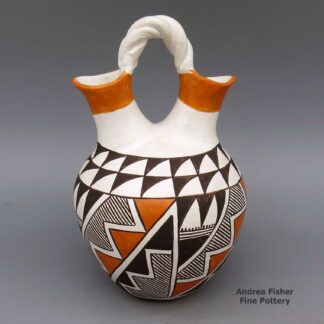
Elizabeth Waconda, lkac2l315, Wedding vase with braided handle and geometric design
$650.00 Add to cart -
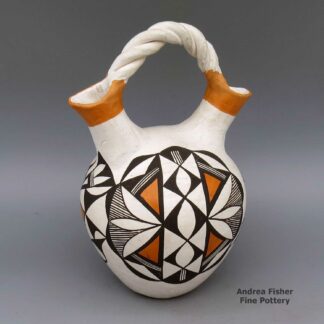
Eva Histia, lkac2l308, Wedding vase with braided handle and geometric design
$800.00 Add to cart -
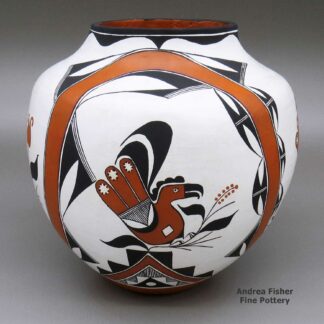
Franklin Peters, mvac3b097, Polychrome jar with a parrot, flower and geometric design
$650.00 Add to cart -

Sandra Victorino, zzac3a233m1, Jar with a parrot design
$1,300.00 Add to cart -
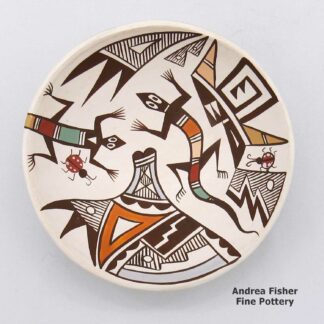
Sharon Lewis, lkac2l290: Miniature polychrome bowl with lizard, ladybug, and geometric design
$125.00 Add to cart -
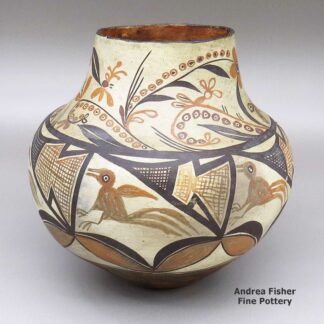
Unknown Acoma Potter, rsac3a061, Jar with bird, flower, fine line and geometric design
$1,700.00 Add to cart -

Unknown Acoma Potter, zzac3b275, Polychrome jar with two opening and a flower and geometric design
$425.00 Add to cart
Showing all 7 results